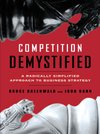Competition Demystified: A Radically Simplified Approach to Business Strategy
amazon.com
Competition Demystified: A Radically Simplified Approach to Business Strategy

As a first rule of thumb, if you can’t count the top firms in an industry on the fingers of one hand, the chances are good that there are no barriers to entry. The rapid change in market share in table 4.2 confirms the rule. As a second rule of thumb, if over a five-to eight-year period,
the average absolute share change exceeds 5 percentage points, there are no barriers to entry; if the share change is 2 percentage points or less, the barriers are formidable.
Most companies that manage to grow and still achieve a high level of profitability do it in one of three ways. They replicate their local advantages in multiple markets, like Coca-Cola. They continue to focus within their product space as that space itself becomes larger, like Intel. Or, like Wal-Mart and Microsoft, they gradually expand their
... See morecompetitive advantage in general (position 1 in figure 1.3). There are only a few types of competitive advantage (demand, supply, and economies of scale) and two straightforward tests (market-share stability and high return on capital) to confirm their existence.
Competitive advantages that lead to market dominance, either by a single company or by a small number of essentially equivalent firms, are much more likely to be found when the arena is local—bounded either geographically or in product space—than when it is large and scattered. That is because the sources of competitive advantage, as we will see,
... See moreStrategies are indeed plans for achieving and sustaining success. But they are not just any ideas for how to make a product or service and sell it profitably to customers. Rather, strategies are those plans that specifically focus on the actions and responses of competitors.
Either the existing firms within the market are protected by barriers to entry (or to expansion), or they are not. No other feature of the competitive landscape has as much influence on a company’s success as where it stands in regard to these barriers.
“Everything should be made as simple as possible, but not simpler.”
At its core, strategic thinking is about creating, protecting, and exploiting competitive advantages.